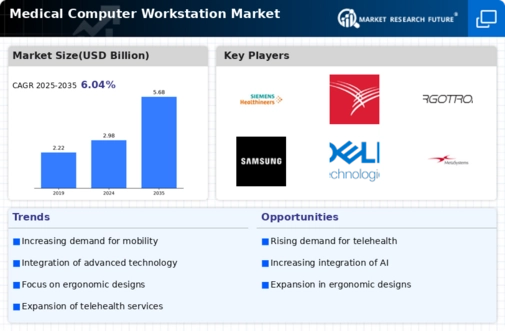The Medical Computer Workstation Market is primarily driven by the increasing demand for efficient healthcare delivery and the rising number of healthcare facilities. As technology continues to advance, there is a growing emphasis on incorporating digital solutions in medical settings. This trend is fueled by the need for improved patient care, enhanced workflow efficiency, and better data management for healthcare professionals.
Moreover, the ongoing shift towards telemedicine and remote patient monitoring has further accelerated the adoption of advanced medical computer workstations, making them essential tools in various healthcare environments. There are significant opportunities to be explored in the realm of customizable and portable workstation solutions. As healthcare providers look to optimize their operations, the demand for flexible workstations that can be tailored to specific clinical settings is on the rise.
Companies can capture this opportunity by innovating designs that integrate emerging technologies such as artificial intelligence and blockchain for improved patient data security and treatment efficiency. Additionally, the growing trend of integrating telehealth capabilities into these workstations can enhance their value proposition. In recent times, the market has seen a shift towards ergonomic designs that prioritize the comfort and well-being of healthcare professionals.
This trend aligns with a broader awareness of workplace health, driving manufacturers to innovate products that reduce physical strain during long hours of use. Furthermore, sustainability has emerged as a significant factor influencing purchasing decisions, with healthcare facilities increasingly seeking eco-friendly workstation solutions. As the sector evolves, staying attuned to these changing dynamics will be crucial for stakeholders looking to thrive in the Medical Computer Workstation Market.
Medical Computer Workstation Market Drivers
Rising Demand for Efficient Healthcare Solutions
The Medical Computer Workstation Market Industry is significantly driven by the increasing need for efficient healthcare solutions. In recent years, healthcare environments have recognized the critical role that technology plays in enhancing the quality of patient care. As hospitals and clinics expand their services to accommodate a growing patient population, the reliance on advanced computer workstations becomes paramount.
These workstations not only facilitate easy access to patient data but also enable healthcare providers to streamline processes, leading to faster diagnoses and improved treatment outcomes. The ongoing digital transformation in healthcare is further propelling the demand for robust medical computer workstations that integrate seamlessly with electronic health records (EHR) and other critical healthcare systems.
Additionally, the push for telemedicine and remote patient monitoring, especially in the wake of the pandemic, has meant that healthcare professionals need reliable, mobile, and versatile workstation solutions to ensure continued patient engagement and care. As a result, this rising demand for efficient healthcare solutions is expected to be a central driver of growth in the Medical Computer Workstation Market Industry over the coming years.
Technological Advancements in Medical Computing
Technological innovation is a pivotal driver of the Medical Computer Workstation Market Industry. The rapid advancements in computing technology, including the introduction of faster processors, enhanced display technologies, and sophisticated software applications, have enabled the development of more powerful and efficient medical workstations. These workstations now come equipped with features such as touch-screen interfaces, ergonomic designs, and improved connectivity options, which enhance usability for healthcare professionals.
As medical imaging techniques evolve and the need for high-resolution data analysis grows, advanced workstations will become indispensable tools in clinical and surgical environments. The continuous evolution of technology aligns perfectly with the goals of healthcare systems striving for better efficiency and patient-centric care.
Increased Focus on Patient Safety and Compliance
Patient safety and regulatory compliance have become paramount concerns in the healthcare sector. The Medical Computer Workstation Market Industry is experiencing growth due to the heightened focus on these aspects, as healthcare providers seek to implement systems that minimize errors and enhance data security. With stringent regulations governing patient data protection and safety, the demand for medical computer workstations that comply with these standards is on the rise.
Additionally, these workstations offer features that aid in error reduction, such as alert systems and decision-support tools, which are crucial for healthcare professionals navigating complex clinical environments.
Medical Computer Workstation Market Segment Insights
The ongoing evolution of healthcare technology suggests that the demand for ergonomic and efficient medical computer workstations is likely to rise, driven by the need for improved patient care and operational efficiency in healthcare settings.
U.S. Department of Health and Human Services






















